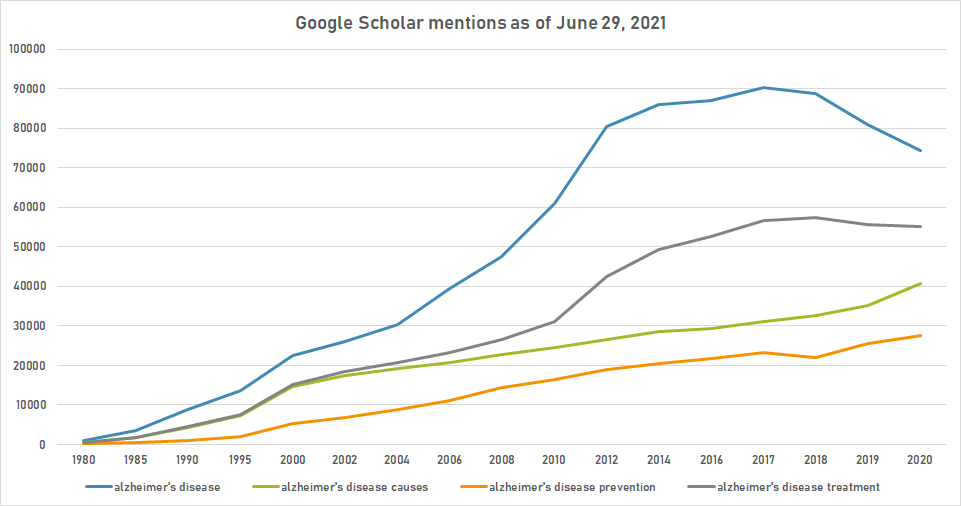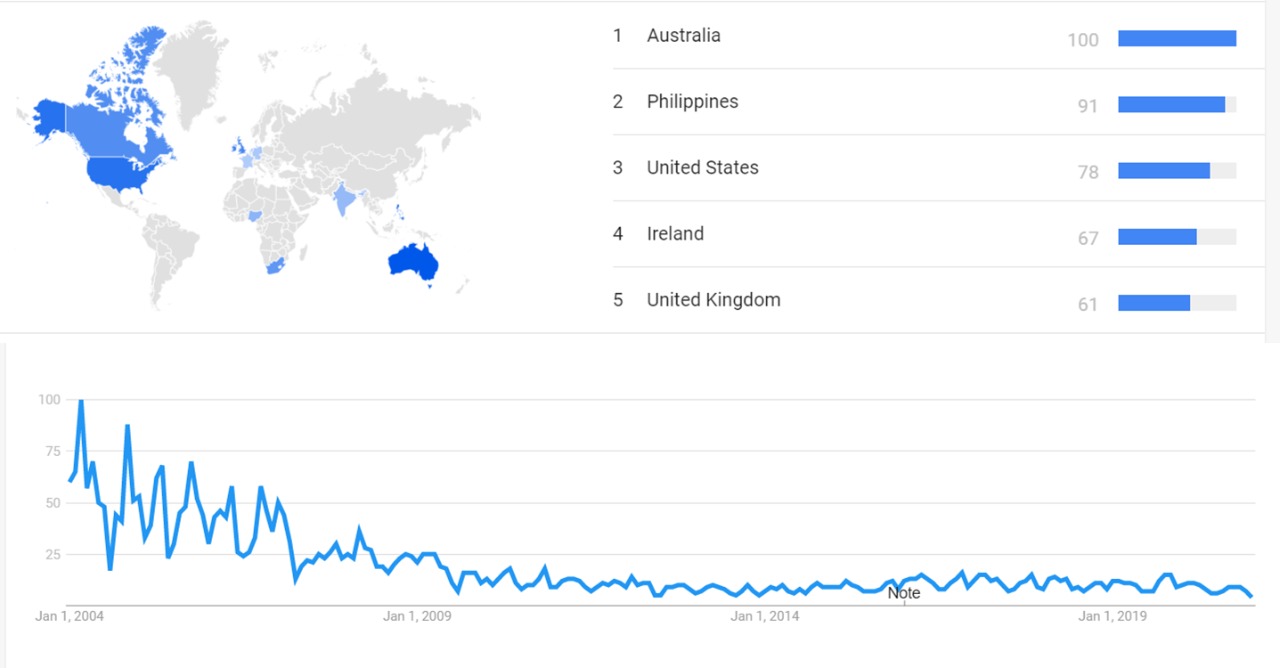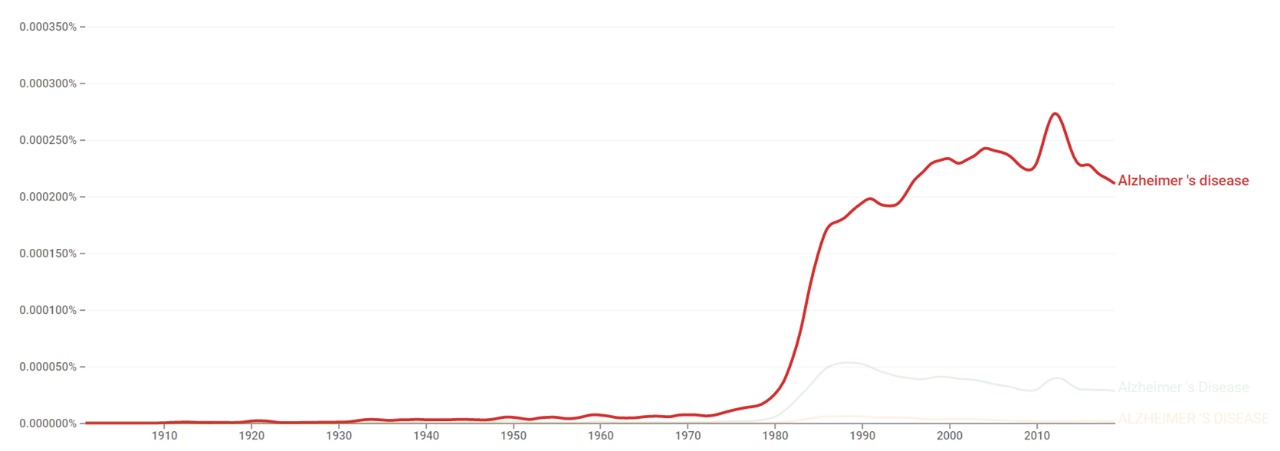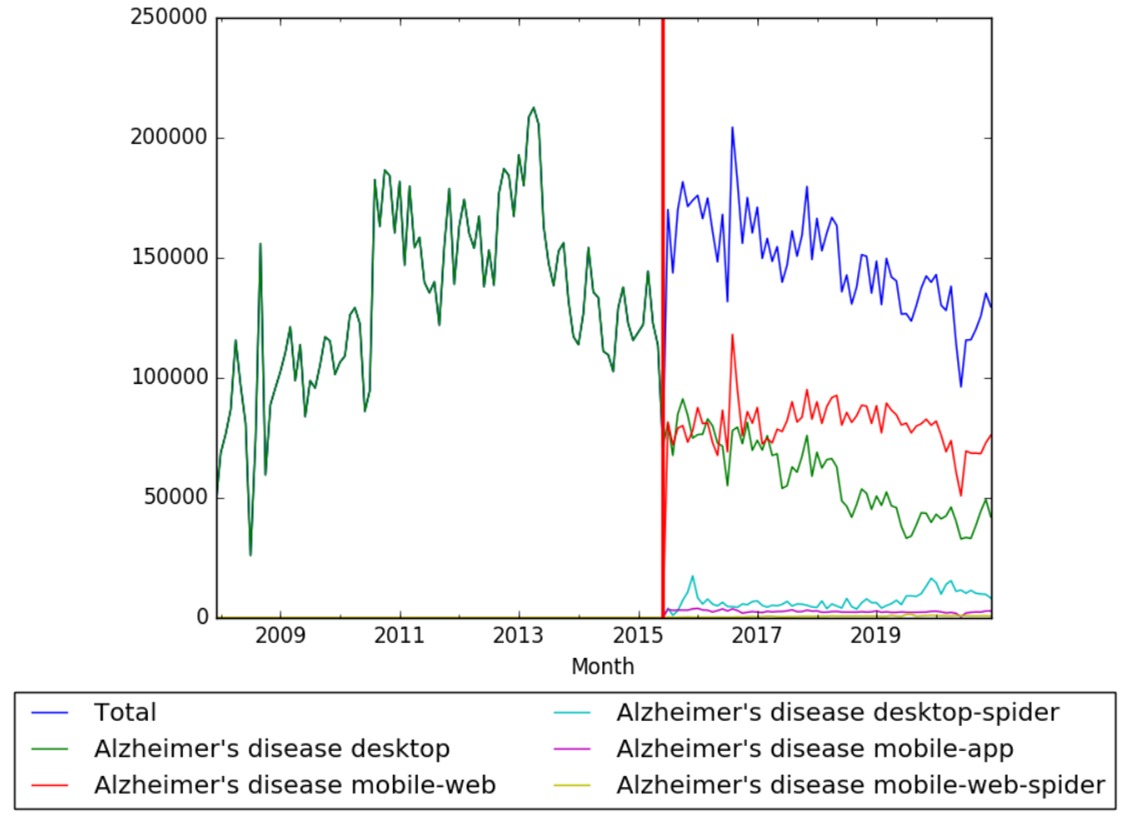Timeline of Alzheimer's disease
Jump to navigation
Jump to search
The content on this page is forked from the English Wikipedia page entitled "Timeline of Alzheimer's disease". The original page still exists at Timeline of Alzheimer's disease. The original content was released under the Creative Commons Attribution/Share-Alike License (CC-BY-SA), so this page inherits this license.
This is a timeline of Alzheimer's disease, describing especially major discoveries, developments and organizations concerning the disease.
Big picture
| Year/period | Key developments |
|---|---|
| Prior to 1890s | Early in History, Solon (638 BC–558 BC) relates alteration in judgment to aging. Plato notes that very old age can have influence on madness.[1] |
| 1890s–1960s | Period of discovery of Alzheimer's disease, starting virtually with the pioneer work by Alois Alzheimer, until the recognition of the disease in the 1960s.[2][3] |
| 1970s | Alzheimer's disease is recognized as the most common form of dementia.[2] |
| 1980s | The organic constituents of the two characteristic damages of Alzheimer's disease are identified: Beta-amyloid and Tau protein. Many organizations focused on Alzheimer's disease start to be founded across the world.[4] |
| 1990s | Several genes responsible for the inherited transmission of Alzheimer's disease are identified: PSEN1, PSEN2 and Apolipoprotein E-e4.[4] The first vaccine is used in mice.[2][3] |
| 2000s–present | At present, there's no cure for Alzheimer's disease.[5] Incidence is higher in developed countries, which correlates with the proportion of senior citizens.[6] |
Full timeline
| Year/period | Type of event | Event | Location |
|---|---|---|---|
| 1892 | Discovery | French pathologist Paul Blocq and Romanian neurologist Gheorghe Marinescu observe senile plaques for the first time.[1][7] | |
| 1898 | Development | Austrian neurologist Emil Redlich relates senile plaques with senile dementia.[1][8] | |
| 1906 | Discovery | At the 37th annual conference of German psychiatrists, physician Alois Alzheimer describes the case of patient Auguste Deter, who had profound memory loss, unfounded suspicions about her family, and other worsening psychological changes. In her brain at autopsy, Alzheimer sees dramatic shrinkage and abnormal deposits in and around nerve cells.[2][9] | Tübingen, Germany |
| 1910 | Development | German psychiatrist Emil Kraepelin, a colleague of Alzheimer, first names "Alzheimer's Disease" in the eighth edition of his book Psychiatrie.[2][10][11] | |
| 1931 | Background | German electrical engineer Max Knoll and German physicist Ernst Ruska co-invent the electron microscope, which can magnify up to 1 million times. After World War II the electron microscope becomes common in major research settings, enabling scientists to study brain cells in more detail.[2][12] | |
| 1968 | Development | Researchers develop the first validated measurement scale for assessing cognitive and functional decline in older adults.[2] | |
| 1974 | Organization | The American National Institute on Aging (NIA) is founded.[2] | Baltimore, United States |
| 1976 | Report | Alzheimer's disease is recognized as the most common form of dementia.[2] | |
| 1976–1977 | Development | Three teams, led by Elaine Perry, D.M. Bowen, and P. Davies demonstrate the alteration of central cholinergic systems in Alzheimer's disease.[1][13] | |
| 1978 | Organization | Alzheimer Society of Canada is founded.[14][15] | Toronto, Canada |
| 1980 | Organization | American Alzheimer's Association is founded.[16] | Chicago, United States |
| 1980 | Organization | Alzheimer's Association Japan is founded. It is involved in research and provides support for those affected by Alzheimer's.[17] | Kyoto, Japan |
| 1982 | Organization | Alzheimer’s Australia is founded. It administers leading edge national dementia programs and services and is funded by the Commonwealth.[14][18][19] | North Ryde, Australia |
| 1983 | Campaign | American president Ronald Reagan designates November as National Alzheimer’s Disease Awareness Month with the purpose of raising awareness for Alzheimer’s disease.[20] | United States |
| 1984 | Discovery | Researchers George Glenner and Caine Wong identify protein known as amyloid beta, the main component of the amyloid plaques found in the brains of Alzheimer patients.[1][2] | |
| 1984 | Organization | Alzheimer Nederland is founded.[14][21][22][23] | Amersfoort, The Netherlands |
| 1984 | Organization | Alzheimer Disease International is founded.[24] | London, United Kingdom |
| 1985 | Organization | Association France Alzheimer is founded. It provides financial help for research.[25][26][27] | Paris, France |
| 1985 | Organization | Alzheimer's South Africa is founded. It provides funds for research.[14][28][29] | Bryanston, South Africa |
| 1986 | Discovery | Belgian physician Jean-Pierre Brion identifies Tau protein as a key component of neurofibrillary tangles, the second pathological hallmark of Alzheimer's disease and another prime suspect in nerve cell degeneration.[2][4] | |
| 1987 | Discovery | Amyloid precursor protein (APP) is discovered. It is the first gene with mutations found to cause an inherited form of Alzheimer's disease.[30] | |
| 1988 | Organization | Federazione Alzheimer Italia is founded. It delivers free training courses for carers, among other activities.[14][31][32] | Milan, Italy |
| 1988 | Organization | Association Alzheimer Suisse is founded. It provides information and help for those affected by Alzheimer's.[14][33][34] | Yverdon-les-Bains, Switzerland |
| 1988 | Organization | Alzheimer's Association of Israel is founded. In 2008, the association launched “In the Armchair with Picasso” art-kit for therapeutic use on those affected with Alzheimer's. This project has brought attention from geriatric professionals around the world.[14][35][36] | Ramat Gan, Israel |
| 1989 | Organization | Deutsche Alzheimer Gesellschaft is founded. It provides funding for research.[14][37][38] | Berlin, Germany |
| 1989 | Organization | Asociación de Lucha contra el Mal de Alzheimer is founded. It elaborates projects and holds its own scientific committee.[14][39][40][41] | Buenos Aires, Argentina |
| 1990 | Organization | Confederación Española de Familiares de Enfermos de Alzheimer is founded. It represents thirteen federations and six associations within the country.[14][42][43] | Pamplona, Spain |
| 1992 | Organization | Alzheimer's & Related Disorders Society of India is founded. It is the first Afro-Asian organization to receive full membership with Alzheimer Disease International and has an official relationship with the WHO.[14][44][45] | Kunnamkulam, India |
| 1992 | Discovery | Presenilin-1 (PS-1) is identified. It is the second gene with mutations found to cause inherited Alzheimer's disease. Variations in this gene are the most common cause of inherited Alzheimer's.[30] | |
| 1993 | Discovery | Presenilin-2 (PS-2) is discovered. It is the third gene with mutations found to cause inherited Alzheimer's disease.[30][46] | |
| 1993 | Discovery | Apolipoprotein E-e4 (APOE4) is discovered. It is the first gene variation found to increase risk of Alzheimer's disease and remains the risk gene with the greatest known impact.[30][47] | |
| 1993 | Development | The United States Food and Drug Administration (FDA) approves tacrine (Cognex) as the first drug specifically targeting Alzheimer's disease memory and thinking symptoms.[2] | United States |
| 1994 | Alzheimer Disease International launches the first World Alzheimer's Day on September 21.[2] | ||
| 1995 | Development | Researchers announce the first transgenic mouse model that developed Alzheimer-like brain pathology, by inserting one of the human APP genes linked to a rare, inherited form of Alzheimer's disease.[2][48] | |
| 1996 | Development | Donepezil is approved for use in all stages of Alzheimer's disease.[49] | United States |
| 1999 | Development | First report announcing that injection of transgenic "Alzheimer" mice with beta-amyloid prevents the animals from developing plaques and other Alzheimer's disease-like brain changes.[2] | |
| 2001 | Development | Galantamine is approved for use in mild to moderate stages of Alzheimer's disease.[49] | United States |
| 2002 | Organization | The Federación Mexicana de Alzheimer is founded. It holds its own scientific committee.[14][50][51] | Monterrey, Mexico |
| 2003 | Development | Memantine is approved for use in moderate to severe stages of Alzheimer's disease.[49] | United States |
| 2003 | Study | The National Alzheimer's Disease Genetics Study begins. Blood samples are collected from families with several members who developed Alzheimer's late in life to identify additional Alzheimer's risk genes.[11] | United States |
| 2006 | Development | Rivastigmine is approved for use in all stages of Alzheimer's disease.[49] | United States |
| 2008 | Organization | The International Society to Advance Alzheimer Research and Treatment is founded.[2][52] | |
| 2009 | Organization | The International Conference on Alzheimer's Disease becomes an annual event.[2] | |
| 2010 | Development | A database is launched containing information of more than 4000 patients with Alzheimer's disease who participated in 11 pharmaceutical industry-sponsored clinical trials of Alzheimer's treatments.[11][53] | United States |
| 2012 | Organization | Multinational research consortium Dominantly Inherited Alzheimer Network (DIAN), launches the first major clinical trial testing pharmacotherapy to prevent the onset of Alzheimer’s disease symptoms in people who inherited an autosomal dominant mutation putting them at high risk for the disease.[2] | |
| 2013 | Scientific development | International Genomics of Alzheimer’s Project (IGAP) researchers identify 20 genetic variations associated with increased risk of Alzheimer’s disease.[2] | |
| 2013 | Campaign | The G8 Dementia Summit launches an international effort to fight Alzheimer’s disease and find a cure by 2025.[54] | United Kingdom |
| 2014 | Discovery | Researchers at Rush University come to the conclusion that rates of death caused by Alzheimer’s disease are found to be much higher than reported on death certificates. The study is performed on organs donated from 2,566 persons aged 65 years and older without dementia at baseline.[2][55] | United States |
| 2016 | Epidemiology | According to Alzheimer Disease International, nearly 44 million people have Alzheimer’s disease or a related dementia at a worldwide level.[56] | |
| 2017 (November) | Microsoft founder Bill Gates announces donation of US$100 million to Alzheimer’s research, dividing the money between startup ventures and an established private-public research partnership.[57] |
Numerical and visual data
Google Scholar
The following table summarizes per-year mentions on Google Scholar as of June 29, 2021.
| Year | alzheimer's disease | alzheimer's disease causes | alzheimer's disease prevention | alzheimer's disease treatment |
|---|---|---|---|---|
| 1980 | 973 | 525 | 102 | 490 |
| 1985 | 3,550 | 1,770 | 409 | 1,840 |
| 1990 | 8,740 | 4,350 | 929 | 4,570 |
| 1995 | 13,700 | 7,400 | 1,910 | 7,520 |
| 2000 | 22,400 | 14,700 | 5,290 | 15,200 |
| 2002 | 26,000 | 17,400 | 6,860 | 18,300 |
| 2004 | 30,300 | 19,300 | 8,920 | 20,600 |
| 2006 | 39,300 | 20,600 | 11,100 | 23,200 |
| 2008 | 47,600 | 22,800 | 14,400 | 26,500 |
| 2010 | 61,000 | 24,600 | 16,400 | 31,200 |
| 2012 | 80,300 | 26,400 | 18,900 | 42,500 |
| 2014 | 85,900 | 28,600 | 20,500 | 49,200 |
| 2016 | 87,000 | 29,400 | 21,700 | 52,700 |
| 2017 | 90,300 | 31,200 | 23,200 | 56,600 |
| 2018 | 88,700 | 32,700 | 22,000 | 57,400 |
| 2019 | 80,900 | 35,000 | 25,500 | 55,500 |
| 2020 | 74,400 | 40,800 | 27,600 | 55,200 |

Google trends
The chart below shows Google Trends data for Alzheimers disease (search term) from January 2004 to January 2021, when the screenshot was taken.[58]

Google Ngram Viewer
The chart below shows Google Ngram Viewer data for Alzheimer's disease, from 1900 to 2019.[59]

Wikipedia views
The chart below shows pageviews of the English Wikipedia page Alzheimer's disease, drom December 2007 to December 2020.[60]

What the timeline is still missing
See also
References
- ↑ 1.0 1.1 1.2 1.3 1.4 "Histoire de la maladie d'Alzheimer" (PDF). Retrieved 11 August 2016.
- ↑ 2.00 2.01 2.02 2.03 2.04 2.05 2.06 2.07 2.08 2.09 2.10 2.11 2.12 2.13 2.14 2.15 2.16 2.17 2.18 2.19 "Major Milestones in Alzheimer's and Brain Research". Retrieved 9 August 2016.
- ↑ 3.0 3.1 "L'histoire de la Maladie d'Alzheimer". Retrieved 11 August 2016.
- ↑ 4.0 4.1 4.2 "Historique de la maladie Alzheimer". Retrieved 11 August 2016.
- ↑ "Treatments for Alzheimer's disease". Retrieved 11 August 2016.
- ↑ Chengxuan Qiu, Miia Kivipelto, Eva von Strauss (2009). "Epidemiology of Alzheimer's disease: occurrence, determinants, and strategies toward intervention". Dialogues Clin Neurosci. 11: 111–28. PMC 3181909. PMID 19585947.
{{cite journal}}: CS1 maint: multiple names: authors list (link) - ↑ Buda O, Arsene D, Ceausu M, Dermengiu D, Curca GC (January 2009). "Georges Marinesco and the early research in neuropathology". Neurology. 72: 88–91. doi:10.1212/01.wnl.0000338626.93425.74. PMID 19122036.
{{cite journal}}: CS1 maint: multiple names: authors list (link) - ↑ Castellani, Rudy. Molecular Pathology of Alzheimer's Disease. p. 9.
- ↑ "History Module: Dr. Alois Alzheimer's First Cases". Retrieved 11 August 2016.
- ↑ Hanns Hippius, Gabriele Neundörfer (2003). "The discovery of Alzheimer's disease". Dialogues Clin Neurosci. 5: 101–8. PMC 3181715. PMID 22034141.
- ↑ 11.0 11.1 11.2 "Proposed Alzheimer's criteria call for early physician intervention". Retrieved 12 August 2016.
- ↑ Tim Palucka. "Overview of Electron Microscopy". Retrieved 11 August 2016.
- ↑ P. Francis, A. Palmer, M. Snape, G. Wilcock (February 1999). "The cholinergic hypothesis of Alzheimer's disease, a review of progress". J. Neurol. Neurosurg. Psychiatr. 66: 137–47. doi:10.1136/jnnp.66.2.137. PMC 1736202. PMID 10071091.
{{cite journal}}: CS1 maint: multiple names: authors list (link) - ↑ 14.00 14.01 14.02 14.03 14.04 14.05 14.06 14.07 14.08 14.09 14.10 14.11 "Alzheimer associations". Retrieved 11 August 2016.
- ↑ "Alzheimer Society of Canada". Retrieved 10 August 2016.
- ↑ "Alzheimer's Association". Retrieved 10 August 2016.
- ↑ "Japan steps up search for Alzheimer's cure". Retrieved 13 August 2016.
- ↑ "Alzheimer's Australia". Retrieved 21 November 2016.
- ↑ "About Alzheimer's Australia". Retrieved 13 August 2016.
- ↑ "National Alzheimer's Disease Awareness Month". Retrieved 11 August 2016.
- ↑ "Alzheimer Nederland". Retrieved 21 November 2016.
- ↑ "Alzheimer Nederland". Retrieved 10 August 2016.
- ↑ "Alzheimer's Society/Alzheimer Nederland knowledge exchange fellowships". Retrieved 13 August 2016.
- ↑ "Alzheimer's Disease International". Retrieved 10 August 2016.
- ↑ "France Alzheimer". Retrieved 21 November 2016.
- ↑ Ando K, Laborde Q, Lazar A, Godefroy D, Youssef I, Amar M, Pooler A, Potier MC, Delatour B, Duyckaerts C (2014). "Inside Alzheimer brain with CLARITY: senile plaques, neurofibrillary tangles and axons in 3-D". Acta Neuropathol. 128: 457–9. doi:10.1007/s00401-014-1322-y. PMC 4131133. PMID 25069432.
{{cite journal}}: CS1 maint: multiple names: authors list (link) - ↑ "Association France Alzheimer". Retrieved 10 August 2016.
- ↑ "Alzheimer's South Africa". Retrieved 11 August 2016.
- ↑ "Dementia: SA's hidden disease". Retrieved 13 August 2016.
- ↑ 30.0 30.1 30.2 30.3 "The Search for Alzheimer's Causes and Risk Factors". Retrieved 9 August 2016.
- ↑ "Alzheimer Europe" (PDF). Retrieved 13 August 2016.
- ↑ "Federazione Alzheimer Italia". Retrieved 10 August 2016.
- ↑ "Dégénérescence. La véritable bataille contre l'alzheimer commence". Retrieved 13 August 2016.
- ↑ "Association Alzheimer Suisse". Retrieved 11 August 2016.
- ↑ "Virtual museum tours perk up people with dementia". 13 August 2016.
- ↑ "Alzheimer's Association of Israel". Retrieved 10 August 2016.
- ↑ "Deutsche Alzheimer Gesellschaft". Retrieved 21 November 2016.
- ↑ "DAlzG offer research funding opportunity". Retrieved 13 August 2016.
- ↑ "Las demencias, en la agenda política mundial". Retrieved 13 August 2016.
- ↑ "Asociación de Lucha contra el Mal de Alzheimer". Retrieved 13 August 2016.
- ↑ "Asociación de Lucha contra el Mal de Alzheimer". Retrieved 10 August 2016.
- ↑ "Alzheimer España". Retrieved 13 August 2016.
- ↑ "Confederación Española de Familiares de Enfermos de Alzheimer". Retrieved 10 August 2016.
- ↑ "Alzheimer's & Related Disorders Society of India". Retrieved 13 August 2016.
- ↑ "Alzheimer's & Related Disorders Society of India". Retrieved 10 August 2016.
- ↑ "ALZHEIMER'S DRUG APPROVED BY F.D.A." Retrieved 11 August 2016.
- ↑ Mengying Liu, Chen Bian, Jiqiang Zhang, Feng Wen (2014). "Apolipoprotein E gene polymorphism and Alzheimer's disease in Chinese population: a meta-analysis". Sci Rep. 4: 4383. doi:10.1038/srep04383. PMC 3955907. PMID 24632849.
{{cite journal}}: CS1 maint: multiple names: authors list (link) - ↑ "Mouse Models of Alzheimer's Disease: A Quest for Plaques". ILAR Journal. 43: 89–99. doi:10.1093/ilar.43.2.89.
- ↑ 49.0 49.1 49.2 49.3 "Current Alzheimer's Treatments". Retrieved 11 August 2016.
- ↑ "Alzheimer Mexico". Retrieved 13 August 2016.
- ↑ "Federación Mexicana de Alzheimer". Retrieved 10 August 2016.
- ↑ Adejare, Adeboye. Drug Discovery Approaches for the Treatment of Neurodegenerative Disorders. Retrieved 21 November 2016.
- ↑ Deborah Brauser. "New Database of Alzheimer's Trials Available to Researchers, Clinicians". Retrieved 12 August 2016.
- ↑ "History of Alzheimer's: Major Milestones". Retrieved 11 August 2016.
- ↑ James BD, Leurgans SE, Hebert LE, Scherr PA, Yaffe K, Bennett DA. "Contribution of Alzheimer disease to mortality in the United States". Neurology. 82: 1045–50. doi:10.1212/WNL.0000000000000240. PMC 3962992. PMID 24598707.
{{cite journal}}: CS1 maint: multiple names: authors list (link) - ↑ "2016 Alzheimer's Statistics". Retrieved 11 August 2016.
- ↑ "Bill Gates personally donates $100 million to Alzheimer's research". washingtontimes.com. Retrieved 24 May 2018.
- ↑ "Alzheimer's disease". trends.google.com. Retrieved 6 January 2021.
- ↑ "Alzheimer's disease". books.google.com. Retrieved 13 January 2021.
- ↑ "Wikipedia Views: results". wikipediaviews.org. Retrieved 26 January 2021.